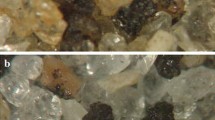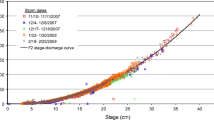Abstract
Urban and suburban storm water runoff from ten locations in eastern Massachusetts was analyzed for 39 polycyclic aromatic hydrocarbons (PAHs) compounds. Similar profiles in PAH composition were observed for groups of samples and appear to reflect land use. The largest group includes, urban storm water from areas with a mix of industrial, commercial, and residential use. Fluoranthene, phenanthrene, pyrene, chrysene, and benzo (b) fluoranthene were the predominant compounds in this group, but lighter molecular weight PAHs were also present. Sources of PAHs to storm water include a combination of petroleum and combustion. The profile of PAH compounds in local atmospheric deposition was similar to urban storm water, but differed in several of the predominant compounds. PAHs in storm water could increase the levels of these compounds in nearshore sediments and may be the most important source of high molecular weight PAHs to these environments.
Similar content being viewed by others
Literature Cited
Alber, M. and A. B. Chan. 1994. Sources of contaminants to Boston Harbor: Revised loading estimates. Massachusetts Water Resources Authority, Technical Report No. 94-1. Charlestown, Massachusetts.
Boehm, P. D. andJ. W. Farrington. 1984. Aspects of the polycyclic aromatic hydrocarbon geochemistry of recent sediments in the Georges Bank region.Environmental Science and Technology 18:840–845.
Botello, A. V., S. F. Villanueva, G. G. Diaz, andE. Escobar-Briones. 1998. Polycyclic aromatic hydrocarbons in sediments from Salina Cruz Harbour and coastal areas, Oaxaca, Mexico.Marine Pollution Bulletin. 36:554–558.
Brown, G. andW. Maher. 1992. The occurrence, distribution, and sources of polycyclic aromatic hydrocarbons in the sediments of the Georges River estuary, Australia.Organic Geochemistry 18:657–668.
Evans, K. M., R. A. Gill, andP. W. J. Robinson 1990. The PAH and organic content of particle size fractions.Water, Air and Soil Pollution 51:13–31.
Geschwend, P. M., andR. A. Hites. 1981. Fluxes of polycyclic aromatic hydrocarbons to marine and lacustrine sediments in the north eastern United States.Geochimica et Cosmochimica Acta 42:2359–2367.
Golomb, D., D. Ryan, N. Eby, andJ. Underhill. 1996. Atmospheric deposition of toxic metals and polyaromatic hydrocarbons onto Massachusetts Bay. Massachusetts Bays Program, Boston, Massachusetts.
Golomb, D., D. Ryan, N. Eby, S. Zemba, T. Wade, andJ. Underhill. 1993. Atmospheric deposition of contaminants onto Massachusetts and Cape Cod Bays. Massachusetts Bays Program, Boston, Massachusetts.
Heit, M. 1984. The relationship of a coal fired power plant to the level of polycyclic aromatic hydrocarbons (PAH) in the sediment of Cayuga Lake.Water, Air, and Soil Pollution 24:41–61.
Heit, M. andY. L. Tan. 1979. The concentrations of selected polynuclear aromatic hydrocarbons in the surface sediments of some fresh and marine waters of the United States. Environ. Q. Environmental Measurement Laboratory, New York. April, Appendix 13-1139; cited in Brown and Maher (1992).
Hoffman, E. J. 1985. Urban runoff pollutant inputs to Narragansett Bay: Comparison to point sources, p. 159–164.In Proceedings from the Conference on Perspectives on Nonpoint Source Pollution. Report No. 440/5-85-001. U.S. Environmental Protection Agency, Kansas City, Missouri.
Hoffman, E. J., J. M. Latimer, G. L. Mills, andJ. G. Quinn. 1982. Petroleum hydrocarbons in urban runoff from a commercial land use area.Journal of the Water Pollution Control Federation 54:1517–1525.
Hoffman, E. J., J. M. Latimer, G. L. Mills, andJ. G. Quinn. 1984. Urban runoff as a source of polycyclic aromatic hydrocarbons to coastal waters.Environmental Science and technology 18:580–587.
Mackay, D., W. Y. Shiu, andK. G. Ma. 1992. Illustrated Hand-book of Physical-Chemical Properties and Environmental Fate for Organic Chemicals, Volume II. Polynuclear Aromatic Hydrocarbons, Polychlorinated Dioxins and Dibenzofurans. Lewis Publishers, Ann Arbor, Michigan.
Massachusetts Bays Program—Coastal Zone Management. 1991. Massachusetts Bays 1991 Comprehensive Conservation and Management Plan (CCMP), Massachusetts Bays Program, Boston, Massachusetts.
Menzie, C. A., B. B. Potocki, andJ. Santodonato. 1992. Exposure to carcinogenic PAHs in the environment.Environmental Science and Technology 26:1278–1284.
Menzie-Cura & Associates, Inc. 1991. Sources and loading of pollutants to Massachusetts Bay. Massachusetts Bays Program, Boston, Massachusetts.
Menzie-Cura & Associates, Inc. 1995. Measurements and loading of polycyclic aromatic hydrocarbons (PAHs) in storm water, combined sewer overflows, rivers, and publicly owned treatment works (POTWs) discharging to Massachusetts Bay. Report MBP-95-06. Massachusetts Bays Program Boston, Massachusetts.
Neff, J. M. 1979. Polycyclic Aromatic Hydrocarbons in the Aquatic Environment.—Sources, Fates and Biological Effects. Applied Science Publishers, LTD, London.
Prahl, F. G. andR. Carpenter. 1983. Polycyclic aromatic hydrocarbons (PAH) phase associations in Washington coastal sediment.Geochimica et Cosmochimica Acta 47:1013–1023.
Author information
Authors and Affiliations
Corresponding author
Rights and permissions
About this article
Cite this article
Menzie, C.A., Hoeppner, S.S., Cura, J.J. et al. Urban and suburban storm water runoff as a source of polycyclic aromatic hydrocarbons (PAHs) to Massachusetts estuarine and coastal environments. Estuaries 25, 165–176 (2002). https://doi.org/10.1007/BF02691305
Received:
Accepted:
Issue Date:
DOI: https://doi.org/10.1007/BF02691305




